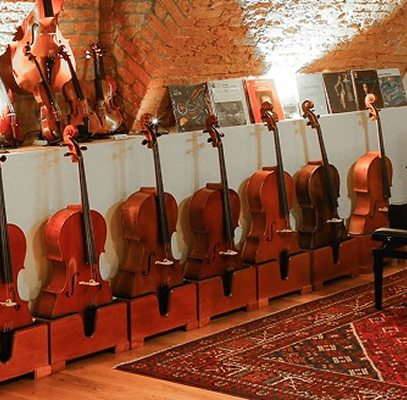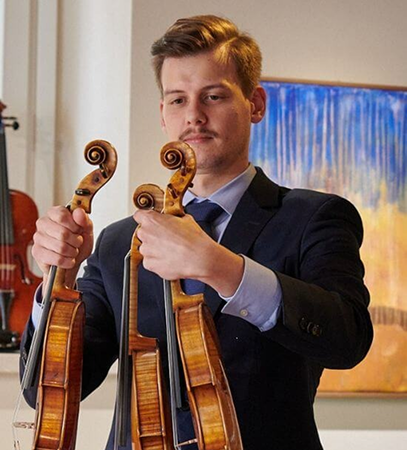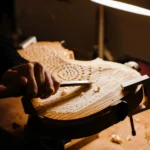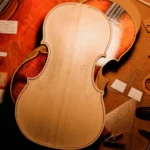Viola vs Violin: 5 Main Differences Between These Instruments
Back to BlogThe viola and violin may look alike, but their differences run deep. From size and tuning to tone and character, each has a unique voice that defines its role in music.
At first glance, it’s easy to mistake a viola for a violin. Their graceful wooden curves and glossy varnish are nearly identical to the untrained eye. But if you take a closer look (or better yet, listen) you’ll discover two distinct voices within the same string family.
Beyond their physical similarities lies a fascinating dialogue between tone and temperament, shaped by centuries of craftsmanship.
The violin, celebrated for its brilliance and expressive agility, commands attention with clarity and projection. The viola, on the other hand, embodies a quieter strength, all because of its darker voice which is more introspective.
These contrasts, refined over hundreds of years by master luthiers, reveal not just differences in design but in philosophy: two instruments born from the same idea, yet destined for distinct.
So, why are they so often confused?
Because they share not only the same ancestry but also many physical traits: four strings, similar construction, and a comparable playing posture. However, for those who know what to look (and listen) for, the contrasts are profound.
Part of the confusion comes from the subtle craftsmanship decisions that define each instrument. The differences in body proportions, neck length, and arch curvature are often measured in millimeters,, yet dramatically influential in sound production and playability.
Even the varnish composition and wood density affect resonance, giving each instrument a distinct personality.
To the casual observer, they appear twins; to a luthier or seasoned musician, they are unmistakably unique creations with their own tonal DNA.
5 Main Differences between the violin and the viola
Below, we explore the five main differences between the violin and the viola, from craftsmanship to sound character, to help you appreciate what makes each instrument unique.
1. Bow
Although they may look alike, the viola’s bow is slightly heavier and shorter than the violin’s. The balance point is closer to the frog, giving violists better control over the instrument’s thicker strings.
The violin bow, on the other hand, is designed for agility. Ideal for fast, articulate passages that demand precision and brilliance.
2. Arch and Body Size
Perhaps the most obvious difference lies in size. The viola is typically centimeters longer than the violin, with a deeper body arch to accommodate its darker tonal range. This extra resonance chamber allows the viola to produce its signature warm timbre, sitting perfectly between the violin and the cello in the orchestral register.
In the hands of a skilled maker, the viola’s proportions become an art form in themselves, balancing power and comfort without sacrificing tonal beauty.
3. Sound
If the violin is the soprano of the string family, the viola is its alto—the instrument that binds brightness and depth into a single, human-like timbre. Though both share the same materials and luthier traditions, their difference in body size and string length creates a fundamentally distinct acoustic character.
The violin’s shorter strings and higher tuning (G–D–A–E) produce tones that are clear, penetrating, and agile. Its frequencies sit comfortably above the orchestral texture, allowing it to project melodic lines even against a full symphonic backdrop. In the hands of a skilled player, the violin can shimmer with brilliance—its upper register almost vocal in its expressiveness.
By contrast, the viola’s tuning (C–G–D–A) places it a perfect fifth lower, immediately giving it a broader wavelength and a warmer, darker tone. Its thicker strings and larger resonating chamber enhance the instrument’s lower partials, resulting in a rounder and more complex harmonic spectrum. The sound blooms rather than cuts, enveloping the listener in warmth and depth rather than sparkle.
At Amorim Fine Violins, luthiers meticulously shape these tonal profiles through arching, wood density, and varnish thickness, optimizing each instrument for either projection (in violins) or resonance and color (in violas). These nuanced design decisions ensure that the personality of each instrument (be it fiery or introspective) comes fully alive in the musician’s hands.
4. Function and Place in the Orchestra
The violin often carries the melody, leading harmonies and bright motifs. Its brilliance cuts through the texture, giving it the spotlight. The viola, conversely, weaves the inner harmonies, enriching the sound with depth and emotional color.
In chamber ensembles, the viola bridges the sonic space between the violin and cello—subtle yet indispensable. Its role might be less conspicuous, but to a discerning ear, it’s the glue that binds the ensemble’s sound together.
5. Strings
While the violin’s strings are tuned G–D–A–E, the viola’s are tuned a fifth lower: C–G–D–A.
This lower tuning gives the viola its darker resonance and requires thicker strings, which in turn influence bow technique and left-hand positioning. The increased string tension also affects playability, demanding greater bow pressure and control to produce a clear, focused tone.
A Brief History. Which came first?
According to The Viola & Violists resource, the viola and violin share the same 16th-century Italian origins, though some historians argue that the viola may have appeared first. The reasoning comes from language and usage: in Italian and German, the term viola da braccio refers to an instrument “played on the arm,” distinguishing it from instruments played between the legs, like the cello. Since violino is a diminutive of viola, this linguistic trail suggests that the smaller violin could have developed later.
Later, prominent makers such as Andrea Amati in Cremona and later Antonio Stradivari further refined the violin family. Amati is credited with early models of both the violin and viola in the 16th and 17th centuries, while Stradivari elevated craftsmanship, projection, and tonal sophistication through the late 17th and early 18th centuries.
Although they emerged from the same craft tradition, the instruments soon took on distinct identities. The violin became celebrated for its brilliance and agility, while the viola developed a deeper, more resonant voice shaped by its larger body and lower tuning.
Can a Violinist Play Viola? And Vice Versa?
Technically, yes, but not without adaptation.
A violinist switching to viola must adjust to different finger spacing, a heavier bow, and alto clef reading. Conversely, a violist moving to violin gains agility but must adapt to higher tuning and lighter bow strokes.
Many professional musicians master both, as the experience deepens their understanding of harmony and ensemble dynamics.
How to Choose the Best One for You
Your choice depends on your musical identity.
If you seek brilliance, speed, and projection, the violin might be your voice. But if you crave depth, warmth, and complexity, the viola will resonate with your soul.
For collectors, craftsmanship plays an even greater role. Every curve, arch, and varnish layer defines how these instruments breathe and respond. Whether you’re drawn to the lyricism of a violin or the introspection of a viola, a finely crafted piece is more than an instrument, it’s a legacy.
Discover The Intrument that Matches your Style at Amorim Fine Violins
At Amorim Fine Violins, each instrument, whether viola or violin, is hand selected and meticulously set up to bring out its fullest tonal potential. Every detail, from the curvature of the bridge to the right bow, is adjusted to enhance resonance, balance, and projection.
What truly distinguishes violins and violas at Amorim is the harmony between craftsmanship and character. Each piece carries the signature of expert luthiers who understand not only the science of sound but the artistry of emotion.
When you play or collect a violin or viola from Amorim, you’re not simply acquiring an instrument; you’re preserving a legacy of precision, beauty, and depth that continues the finest traditions of Italian violin making.
Visit the collection of violas and violins to discover your perfect match and experience how craftsmanship transforms into music that endures for generations.









